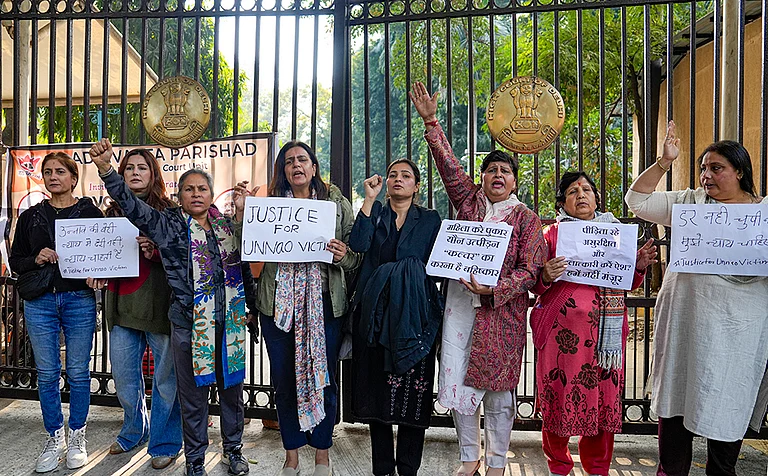This is a very real fear among Calcuttans this monsoon. After all, the hilsa isn’t just a fish; for Bengalis it’s a way of life. And of all the famed piscine delicacies, the hilsa is king, its allure enhanced not just by taste, but also by the fact that it’s available for only three months a year. The ‘taste’ case for this Indian shad is simple: the hilsa is a sea fish that swims upriver to breed. And the most delectable pieces are the ones that go the farthest upriver. In recent times, a host of (mostly manmade) factors is forcing the hilsa to stay away from Bengal’s rivers, change its breeding patterns and even rush towards extinction.
"There is practically no hilsa left in the rivers," says Dr Dibakar Nath, director of the Central Inland Fisheries Research Institute (CIFRI) in Barrackpore. In 2003, of the state-wide catch of 26,000 metric tonnes, a negligible amount was from fresh water—a total reversal of earlier trends. "Thanks to an increasing demand, the hilsa is now netted at the estuary, even before it begins its migratory journey," adds Nath. There was a time when hilsa from the Bay of Bengal would travel as far upstream as Allahabad and Kanpur. But that was before the Farakka Barrage. In 1975, when the barrage was constructed, it was fitted out with a ‘fish ladder’ to facilitate the hilsa’s migration. But it never worked. "There is a 10-foot difference between the water levels on either side of the barrage," says CIFRI principal scientist H.C. Karmakar. "How can we expect the hilsa to negotiate that?" Yet the institute’s research has shown that the hilsa has been particularly resilient: it has more than doubled since its pre-Farakka population, when the catch used to be 5,000-6,000 tonnes (it was 12,000 tonnes last year). Today, however, with rivers shrinking and silting up, or being polluted with effluents, the hilsa stands a lesser chance of survival.
Add to that improved but indiscriminate fishing. Fishermen in Bengal have now started adopting a quick-buck method, by which they trap the juvenile hilsa and sell it for as much as Rs 200 in the market. A quick survey of the catch at Fraserganj in south Bengal (which feeds most of the state) last year showed that of every 1,000 fish, only five were adult. Earlier, fishermen used to catch the hilsa with a gill net which had a mesh size of 4 to 4.5 inches. The smaller fish would slip through the gaps. But in the past few years, they have switched to the monofilament ‘disco’ net, which—with a mesh size of only 1.5 to 2 inches—traps even the spawn, thereby preventing it from breeding in the next season. That’s not all. In the winter months of November-March, when the hilsa spawn is swimming out to sea from the river, it’s picked up by dragnets and bag nets attached to trawlers. Either way, the juvenile hilsa are not allowed to grow and breed. Last year, the winter catch yielded over 150 tonnes of young hilsa (called fry or fingerlings). Fisheries department officials estimated that if they hadn’t been trapped, they might have grown to provide over 500 tonnes of hilsa the following year. According to marine biologist and researcher Madhumita Mukherjee, this has killed off many varieties of hilsa, like the slightly dark Chandana hilsa. The common hilsa, or the Tenualosa ilisha, could be on a similar path. Moreover, five years ago fishermen could pick up a decent catch within nine km of the shoreline. Now they often have to travel as far as 30 km out to sea before they can get a decent haul. Yet consumption hasn’t been affected. As with the Calcutta jeweller, the hilsa forms a major part of many promotions. This year, the Sutanuti Parishad, which stubbornly continues to celebrate Calcutta’s birthday—that isn’t—on August 24, organised for a hoard of hilsa through a week of celebrations. "Now even non-Bengalis have begun to develop a taste for hilsa," says a wholesaler. And the state continues to transport five truckloads—or about 20 tonnes—of hilsa to Bengali neighbourhoods like Chittaranajan Park in Delhi, and to pockets in Madhya Pradesh every week. "All things considered, the hilsa is severely threatened," says U.S. Nandy, director of the state fisheries department.

Spooked by the idea of a drought—or even extinction—of hilsa in the near future, the state government has swung into action. In early September, minister Kiranmoy Nanda will meet Bengal’s leading fishermen’s associations to give final form to certain protective regulations. The net mesh size will be increased from two inches to the previous four, and the trapping of juvenile hilsa will be punishable with fines. On another front, the fisheries department is also pushing for a total ban on fishing in the initial hilsa breeding season, from about May to July. Following in the footsteps of neighbouring Bangladesh, which has already enforced similar curbs, West Bengal’s regulations will probably be in place by the next season.
Point is, will the fishermen, who are clearly trying to make a fast buck from whatever kind of hilsa they can pick up, come around? Pranab Kar, chairman of the All Bengal United Fishermen’s Association, says they will. "We realise that indiscriminate fishing has killed off many types of fish, not just the hilsa," he says. "But we need to make sure fishermen up and down the coastline—in Bengal, Orissa and Andhra Pradesh—follow the same regulations. That’s the only way to avert an ecological imbalance."
And if the hilsa dies out, the over 2.6 lakh people dependent on it will be without a livelihood as well. The fisheries department is trying to check that by coming up with a method of hilsa ranching, by caging out portions of the sea. For the Bengali, nothing is too ambitious to save the beloved hilsa.


























